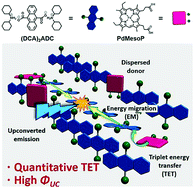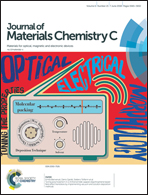Aggregation-free sensitizer dispersion in rigid ionic crystals for efficient solid-state photon upconversion and demonstration of defect effects†
Abstract
Solid-state photon upconversion based on triplet–triplet annihilation (TTA-UC) has attracted much interest because of its potential to circumvent the loss of sub-bandgap photons in photovoltaic cells. There are two important long-standing questions for TTA-UC in solid crystals. Why is the UC efficiency often low in crystalline systems? What is the rational strategy to construct efficient upconverting crystals? In this work, these issues are addressed by employing a simple model system where ionic interactions play a key role. When crystals of an anthracene-based ionic acceptor (emitter) are grown in the presence of anionic donor (sensitizer) molecules, the donor molecules are spontaneously taken up and dispersed homogeneously in acceptor crystals without aggregation. Highly efficient UC is achieved as a consequence of quantitative triplet energy transfer (TET) from the incorporated donor to the surrounding acceptor. It is found that the mechanical grinding of the donor-doped single crystals leads to a significant decrease in UC efficiency, suggesting that trap sites formed in the crystals have a significant negative impact on the UC performance. The important fundamental knowledge obtained from the current ionic crystal system offers rational design guidelines towards the development of efficient TTA-UC systems in the solid-state.

- This article is part of the themed collection: Editor’s Choice: Progress in singlet fission and photon upconversion


 Please wait while we load your content...
Please wait while we load your content...
